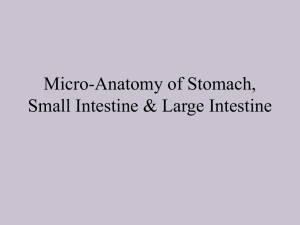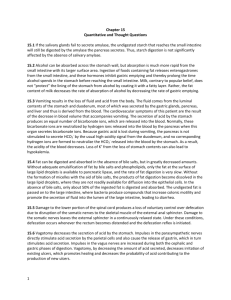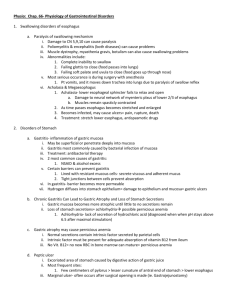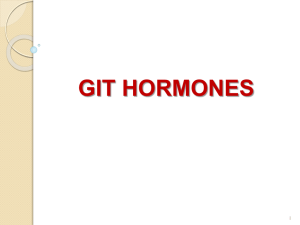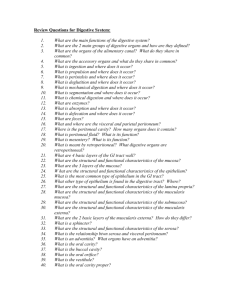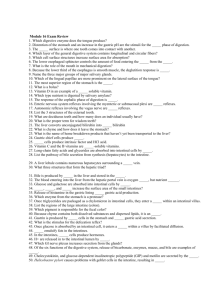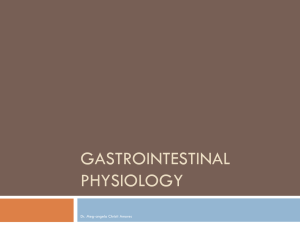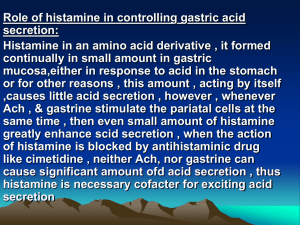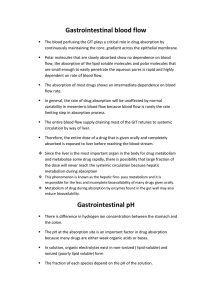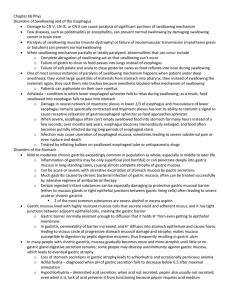Chapter 24
advertisement
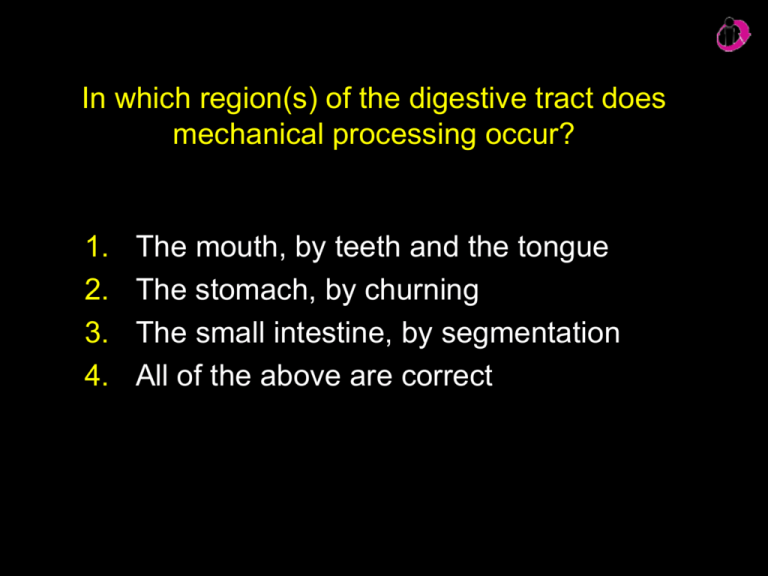
In which region(s) of the digestive tract does mechanical processing occur? 1. 2. 3. 4. The mouth, by teeth and the tongue The stomach, by churning The small intestine, by segmentation All of the above are correct Which disorder increases the rate at which fluids move into the peritoneal cavity? What condition results from the excess fluids in the peritoneal cavity? 1. 2. 3. 4. Liver disease/ascites Gastric ulcers/internal bleeding Diarrhea/dehydration Crohn’s disease/malabsorption What is the importance of the mesenteries? 1. Provide a layer of insulating fat 2. Support and stabilize organs in abdominopelvic cavity 3. Divide abdominal cavity from pelvic cavity 4. All of the above are correct The four major layers of the GI tract are ____. 1. Mucosa, digestive epithelium, lamina propria, and muscularis mucosa 2. Mucosa, submucosa, muscularis externa, and serosa 3. Submucosa, submucosal plexus, myenteric plexus, and serosa 4. None of the above is correct Where are the motor neurons that control smooth muscle contraction and glandular secretions of the GI tract located? 1. 2. 3. 4. In the hypothalamus In the submucosal plexus In the myenteric plexus In the muscularis mucosa Which type of epithelium lines the oral cavity? Why? 1. 2. 3. 4. Simple squamous epithelium/for absorption of nutrients Stratified squamous epithelium/area is subject to abrasion Stratified cuboidal epithelium/because of secretions from glands Simple columnar epithelium/for absorption of nutrients The parotid glands secrete ____, which contain large amounts of ____. 1. A mucous secretion/buffers and lubricants 2. A mixture of glycoproteins and buffers/ salivary amylase 3. Enzymes that work over a broad range of pH/ lingual lipase 4. Serous secretions/salivary amylase Your molars are most useful for ____. 1. 2. 3. 4. Crushing and grinding a tough pizza crust Shredding meat off a bone Nipping the end of a carrot None of the above is correct What is unusual about the muscularis externa of the esophagus? 1. It contains skeletal muscle along the superior one-third of its length. 2. It is surrounded by serosa. 3. It contains a combination of smooth muscle and skeletal muscle along the superior onethird of its length. 4. It contains nerves. Where in the human body is the fauces? 1. 2. 3. 4. In the oral cavity At the distal end of the esophagus Between the lips and the gums Between the oral cavity and the pharynx What is occurring when the soft palate and larynx elevate and the glottis closes? 1. 2. 3. 4. Swallowing Hiccupping Speaking Coughing If parietal cells were not secreting intrinsic factor, what cascade of events could happen? 1. 2. 3. 4. Inflammation of the gastric mucosa/gastric ulcers Limited absorption of vitamin B12/decline in erythropoiesis Limited absorption of vitamin K/decline in manufacture of clotting factors Chief cells are not stimulated/contractions of the gastric wall are inhibited How do the roles of pepsinogen and HCl interact in the stomach? 1. They both digest chyme. 2. HCl is necessary to prevent pepsinogen from digesting proteins. 3. They both kill microorganisms. 4. HCl is necessary for the conversion of pepsinogen to pepsin. When a person suffers from chronic gastric ulcers, the branches of the vagus nerve serving the stomach are sometimes surgically severed. Why? 1. The vagus nerve carries gastric pain sensations. 2. The vagus nerve stimulates gastric motility. 3. The vagus nerve stimulates gastric secretions. 4. The vagus nerve causes ulcers. How do the regional specializations of the small intestine change along its length? 1. The duodenum has small villi and numerous mucous glands. 2. The jejunum has numerous villi for absorption. 3. The ileum contains aggregated lymphoid nodules. 4. All of the above are correct. What effect(s) does the secretion of CCK have on a fatty meal’s entrance to the duodenum? 1. Speeds up gastric emptying 2. Reduced rate and force of gastric contractions 3. Inhibits secretion of gastric acids and enzymes, slowing gastric emptying 4. Increases secretion of gastrin and decreases bile secretion What effect does secretion of secretin by enteroendocrine cells of the duodenum have on the pancreas? 1. It stimulates the secretion of glucagon. 2. It stimulates production of pancreatic buffers that protect the duodenum. 3. It stimulates the secretion of insulin. 4. It promotes production and secretion of pancreatic enzymes. Why is lipid digestion more impaired by damage to the exocrine pancreas than is carbohydrate or protein digestion? 1. Because carbohydrates are partially digested in the mouth and small intestine 2. Because proteins are partially digested in the stomach and small intestine 3. Because the pancreas is the primary site of fat digesting enzymes 4. All of the above are correct Which structures comprise a hepatic triad? 1. Branches of the hepatic portal vein and hepatic artery, and a branch of the bile duct 2. Branches of the cystic duct, common bile duct, and common hepatic duct 3. The superior mesenteric and splenic veins 4. None of the above is correct The liver has more than 200 critical functions. Which of the following is not a liver function? 1. 2. 3. 4. Carbohydrate, lipid, and amino acid metabolism Vitamin and mineral storage Secretion of CCK , storage and concentration of bile Removal of antibodies, circulating hormones, and toxins What are the major histological differences between the large intestine and small intestine? The large intestine ____. 1. 2. 3. 4. Lacks villi, has abundant goblet cells, and deeper intestinal glands Has longer villi, more microvilli, and plicae Has a larger nutrient absorptive surface Produces more enzymes and hormones What is the primary source of flatus emitted from the intestines? 1. 2. 3. 4. Indole and skatole, two nitrogen-containing compounds Ammonia in the form of ammonium ions Indigestible carbohydrates acted on by bacteria Breakdown products of bilirubin How do most chylomicrons enter the lymphatic system? 1. 2. 3. 4. Through the left and right subclavian veins Through lacteals Through the thoracic duct Through the hepatic portal system How does taking fat-soluble vitamins on an empty stomach affect the absorption of those vitamins? 1. 2. 3. 4. The vitamins are not absorbed, because they require presence of other lipids. Having an empty stomach enhances absorption. A different metabolic pathway is used when you have an empty stomach. None of the above is correct. Why is diarrhea potentially life threatening, but constipation is not? 1. Wastes not eliminated as feces will be eliminated through urine. 2. Constipation affects only gastric motility. 3. Constipation causes edema. 4. Diarrhea causes rapid water and electrolyte loss. Which age-related changes in the digestive system are the results of decreased smooth muscle tone? 1. Weaker peristaltic contractions and decrease in motility 2. Thinning of epithelia of the mouth, esophagus and anus 3. Hemorrhoids and esophageal reflux 4. 1 and 3 are correct

